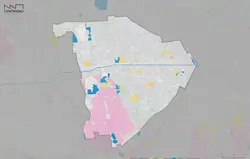MILAN
Designing circularity into the fashion industry

About the pilot area
EX-ANSALDO
Porta Genova is a residential neighborhood located in the heart of Milan, characterized by a population density of 8,214 people per square kilometer and a 12% greenspace share, slightly higher than the city's average. This neighborhood plays a vital role in the circular economy, serving as a repair and reuse hub, as well as a center for innovation.
Porta Genova is home to the repurposed Ex-Ansaldo factory, which previously operated as an electromechanical plant and industrial railway production site. This heritage-listed building now thrives as a hub for cultural, artistic, and creative projects. It is currently under the ownership of the Milanese municipality.

The CENTRINNO pilot team in Milan is dedicated to establishing an active circular manufacturing community, with a focus on design, fashion, and creative activities in the textile sector. Milan's journey began at the local level, involving a comprehensive inventory of actors and their needs across the city.
FOLLOW MILANS CARTOGRAPHY JOURNEY
Milan's key urban challenges
-
Waste generation - With 435.3 kg of generated waste per person and year, Milan’s municipal waste is higher than EU averages
-
Air pollution - Milan is one of the cities with the most severe air pollution in Europe
-
Poverty - Poverty amongst low income workers is a growing concern
-
Water pollution - Soil contamination from former industry infiltrates the Lambro river
Ex-Ansaldo’s challenges
-
Workspaces - Increasing housing prices also affect the rental prices of small workshops and studios
Which insights have been gathered by our local context detectives?
Read through our gallery of local anecdotes, research findings and in-depth analysis
Parallel to Milan’s efforts to understand city and neighbourhood-wide urban challenges, the team has embarked on a journey to get to know the local maker community, their resources and concerns
Who was mapped
Small manufacturers, designers and artisans with circular or sustainable business models
Fab Labs & makerspaces
Educational
services
Why?
-
To build an active network of businesses under the joint branding of Manifattura Milano
-
To facilitate exchange of ideas, discussions and collaborations between Milan’s manufacturers
-
To give visibility to local makers
How was it useful for the Milan pilot team?
-
Mapping helped to showcase actors which are doing a lot of important circular economy work
-
Through mapping, the pilot could identify new businesses and partners which they did not already know before
The mapping of makers in Milan was done by a dedicated team member who used an interview guide in informal conversations with makers.
What local resources were mapped?
Waste streams
Common materials used in production
Tools & infrastructure
How was data collected?
-
Roundtable discussions with stakeholders
-
Open calls for participation in Milano Circolare
-
Workshops, using our Material Flow Mapping worksheet to map local materials, tools and ideas surrounding circularity.
Lessons learned
-
Inclusive mapping strategies are vital to ensure social equity and participation in the process
-
Clearly defined mapping goals are persuasive tools for engaging stakeholders effectively, particularly in large-scale projects
-
Employing CRM software is helpful when working with numerous stakeholders, facilitating the organization and retention of crucial information.
The Milano pilot has started to use mapped stakeholders and their resources in many initiatives to further identify new connections, share ideas and learnings.
-
Manifattura Milano! Manifattura Milano is a platform for promoting artisanship, urban manufacturing and the circular economy in Milan. Our Manufacturing Community Map will keep being published here to give a face to initiatives.
-
Meta Brand’s first product: The Meta Brand is a shared branding given to circular and collaboratively produced products from urban waste materials. The flagship product was a circular tote bag, tested in 2022! By reusing high-end bedsheet waste from a local hotel, women in a social sewing studio were trained to not only reuse local wastes but to learn new textile techniques, such as laser cutting and screen printing (check out the map below).
-
Milano Circolare - During a two-day networking event in February 2023, the Municipality of Milan, NEMA and BASE brought together many of the mapped stakeholders and other circular initiatives that showcased their circular products at a public fair. Next to the exhibition, several panel discussions and workshops were held to discuss challenges and opportunities for Milan’s circular future. Milan’s Manifattura Milano map, of course, was also showcased here!









